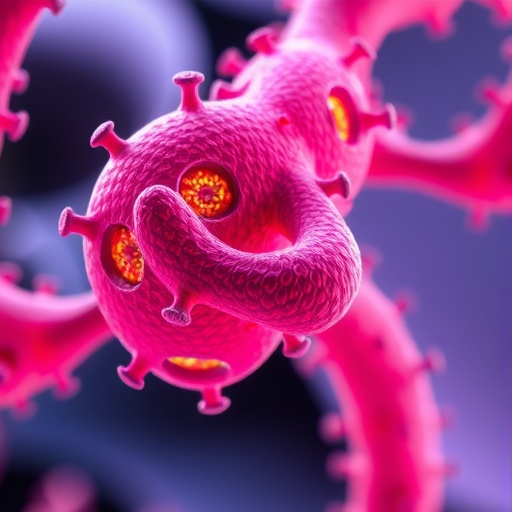In a groundbreaking new study published in Nature Communications, researchers have unveiled novel insights into the complex interplay between the cervicovaginal microbiome, virome, and antiretroviral therapy (ART) in women living with HIV in Peru. The research illuminates how the intricate balance of bacterial and viral communities in the female genital tract fluctuates over time and correlates with patterns of viral shedding and treatment duration. These findings carry substantial implications for improving the management of HIV transmission risks and therapeutic outcomes among women globally.
The study meticulously followed a cohort of women living with HIV, characterizing temporal changes in both the bacteriome—the community of bacteria—and the virome—the population of viruses—in the cervicovaginal environment. By employing advanced sequencing technologies combined with longitudinal sampling, the researchers dissected how these microbial communities evolve in response to antiretroviral therapy and other biological factors. The delicate equilibrium between the bacteriome and virome emerged as a pivotal determinant in whether HIV shedding into the genital tract occurs discordantly, potentially influencing transmission dynamics.
Previous investigations have focused predominantly on the bacterial component of the cervicovaginal microbiota, often linking specific bacterial profiles, such as those dominated by Lactobacillus species, to protective effects in HIV infection. However, this study ventures further by integrating the virome into the analysis, revealing that viral populations—both endogenous and exogenous—coexist and interact with bacterial communities, shaping the local microenvironment profoundly. The virome’s modulation appears not only linked to immune status but is also associated with discordant viral shedding, a phenomenon wherein detectable genital HIV RNA does not mirror systemic viral loads.
.adsslot_PeZjy8O1Ho{ width:728px !important; height:90px !important; }
@media (max-width:1199px) { .adsslot_PeZjy8O1Ho{ width:468px !important; height:60px !important; } }
@media (max-width:767px) { .adsslot_PeZjy8O1Ho{ width:320px !important; height:50px !important; } }
ADVERTISEMENT
Longitudinal data demonstrated significant shifts in both bacteriome and virome compositions over the course of ART. Women with longer ART durations exhibited distinct microbial landscape profiles compared to those newly initiated or off treatment. These alterations included changes in bacterial taxa abundances and viral diversity indices, suggesting therapy’s indirect but influential role in remodeling the cervicovaginal ecosystem. Such remodeling could affect mucosal immunity, barrier functions, and susceptibility to co-infections, implicating these microbial communities as critical players in disease progression and contagion potential.
Mechanistic insights from the study suggest that certain bacterial communities may foster an environment conducive to viral replication or persistence, whereas others may enhance antiviral defense mechanisms. For instance, depletion or imbalance of Lactobacillus species was associated with increased viral shedding, whereas dominance of other anaerobic bacteria correlated with inflammatory states that could compromise mucosal barriers. Concurrently, shifts in the virome, including changes in bacteriophages and eukaryotic viruses, might modulate bacterial populations or directly impact host immune responses, creating a multifaceted network of interactions.
This research also challenges the conventional dogma that views the virome primarily as a passive entity within mucosal sites. Instead, the virome emerges as an active architect of the microbial niche, influencing bacterial community structure and, by extension, host-pathogen interactions. The implications extend beyond HIV to other sexually transmitted infections and reproductive health, suggesting that a comprehensive understanding of mucosal ecosystems must encompass both bacterial and viral constituents.
From a clinical perspective, these findings pave the way for novel diagnostic and therapeutic strategies. Monitoring cervicovaginal bacteriome and virome profiles could serve as biomarkers to identify women at higher risk of genital HIV shedding despite systemic viral suppression. Additionally, microbiome-targeted interventions, such as probiotics or antivirals modulating viral communities, may complement ART to achieve more complete viral control at mucosal reservoirs, reducing transmission risk and improving women’s health outcomes.
The study’s setting in Peru highlights the importance of conducting microbial ecology research across diverse geographic and demographic contexts. Genetic, environmental, sociocultural, and healthcare factors shape host-microbiome and host-virome interactions uniquely in different populations. Understanding these nuances allows for tailored interventions that respect local dynamics while addressing global health challenges.
Another critical aspect underscored by the research is the dynamic nature of cervicovaginal microbial communities over time. This temporal variation demands that assessments and interventions adopt a longitudinal framework rather than single time-point measurements, which may miss transient but clinically significant fluctuations linked to shedding episodes and treatment responses. The integration of longitudinal virome analyses alongside bacterial profiling constitutes a methodological advancement in mucosal immunology research.
Furthermore, the intricate relationships revealed by the study highlight the potential for cross-domain microbial communication influencing HIV pathogenesis. For example, bacteriophages—viruses infecting bacteria—can modulate bacterial competitiveness and biofilm formation, indirectly shaping mucosal environments. Similarly, eukaryotic viruses in the virome may trigger immune activation or suppression, fine-tuning host defenses or inadvertently facilitating viral persistence. This complex network of interactions demands holistic approaches integrating microbial ecology, immunology, and virology.
The authors advocate for expanded research incorporating larger cohorts and mechanistic studies utilizing animal models or in vitro systems to dissect causal links observed in human subjects. Understanding how specific bacterial and viral species mechanistically influence mucosal immunity and HIV reservoirs could inform the development of adjunctive therapies or vaccines optimized for mucosal protection.
In parallel, these findings highlight critical gaps in current HIV management paradigms, particularly in low- and middle-income countries where women bear a disproportionate burden of infection and may face barriers to consistent ART adherence and holistic care. Microbiome-informed interventions could offer low-cost, scalable approaches complementing existing therapies, improving quality of life and reducing transmission.
The new knowledge gained also encourages a reevaluation of HIV transmission risk counseling, considering that genital viral shedding can occur independently of plasma viral load. Incorporating microbial profiling into clinical practice might better stratify transmission risks and guide personalized prevention strategies, such as tailored use of pre-exposure prophylaxis (PrEP) for partners or adjustments in ART regimens.
Finally, the integration of multi-omic technologies to analyze microbial, viral, and host immune factors in a unified framework signifies a significant leap forward in understanding mucosal HIV biology. Employing metagenomics, transcriptomics, and immunoprofiling collectively enables a comprehensive view of the cervicovaginal ecosystem, unraveling previously hidden interdependencies that drive disease processes and therapeutic responses.
This pioneering research thus marks a paradigm shift, emphasizing the necessity of viewing HIV infection and treatment through the lens of complex microbial ecosystems, rather than isolated viral or host factors alone. It opens promising avenues for innovative interventions aimed at harnessing or modulating cervicovaginal microbial communities to achieve sustained viral suppression, minimize shedding, and ultimately curb the global HIV epidemic.
Subject of Research: Longitudinal analysis of cervicovaginal bacteriome and virome dynamics and their association with discordant HIV shedding and antiretroviral therapy duration in women living with HIV.
Article Title: Longitudinal cervicovaginal bacteriome and virome alterations associate with discordant shedding and ART duration in women living with HIV in Peru.
Article References:
Kaelin, E.A., Mitchell, C., Soria, J. et al. Longitudinal cervicovaginal bacteriome and virome alterations associate with discordant shedding and ART duration in women living with HIV in Peru. Nat Commun 16, 7904 (2025). https://doi.org/10.1038/s41467-025-63158-y
Image Credits: AI Generated
Tags: antiretroviral therapy effectsbacterial profiles in HIVHIV cervicovaginal microbiome changesHIV shedding patternsHIV transmission dynamicsHIV treatment outcomesLactobacillus species and HIVlongitudinal microbiome samplingmicrobial communities in female genital tractPeruvian women HIV studyvirome and bacteriome interplaywomen’s health and HIV research





